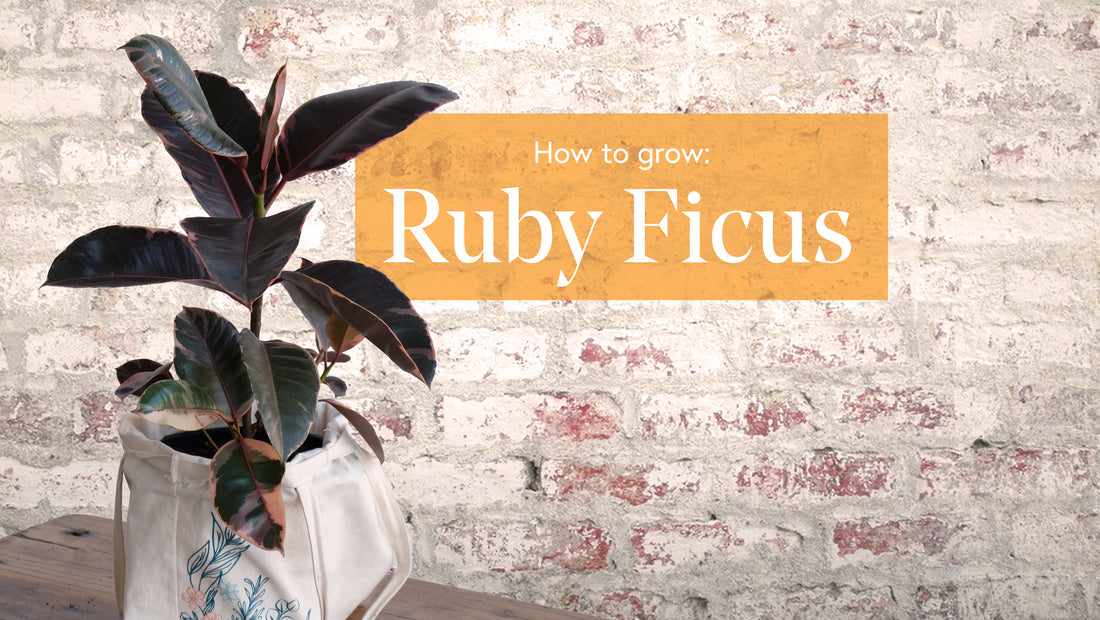Is there anything like a big, striking rubber tree? Their glossy, oval leaves are s t u n n i n g in any variety, but we just can’t get enough of the variegation and colouring of the Ruby. Known to grow up to 40 metres tall in their native climate, these beauties can certainly be a stunning statement if you treat them right. So, armed with a few facts about their care and the common traps to avoid, you can grow a show stopping rubber tree of your own!
How much light does a Ruby Ficus need?
Like all your other favourites, rubber plants will always thrive best in bright, indirect light. Whilst some varieties can tolerate medium light, variegated types will definitely need high lighting to maintain their fab foliage. A light deficiency is also one of the most common causes of leaf drop in these guys, so a bright spot is essential.

When do I water my rubber plant?
Need we say it? No overwatering. This is the other major cause of leaf drop, so look out for any signs of it. As they mature, you can let them dry out quite well between waterings, but try to keep the soil evenly moist when they’re younger. If you’re providing bright light, you should need to water every 1-2 weeks. This can be scaled back in winter, but is of course all dependent on your home and the plant’s position.
What’s the best soil for Ruby Ficus?
Free draining soil, baby! A nice chunky mix with some perlite and bark chips is always a good pick. They’re usually planted in the dense leaf litter of a tropical forest, which is obviously teeming with beneficial microorganisms. Support pellets through your soil will help recreate that environment for your fig.
When should I repot my rubber plant?
Not very often at all, actually! These guys only need an upsize every 2 years or so.. or when the roots start trying to bust out. Make sure your pot has good drainage.
Do rubber figs like humidity?
They do prefer higher humidity, but luckily they’re not too fussy when it’s on the lower side. You might notice some browning on the edges of your leaves if your home is particularly dry, so try to increase humidity in those cases.
What is the best fertiliser for a rubber plant?
Rubber plants looove a feed, so a regular dose of organic, bioactive plant food is essential to growing a big, strong tree. You can use Grow with every drink.

Can you propagate Ruby Ficus?
You can propagate all rubber figs from stems and leaves! Here’s our favourite method:
- In Summer, cut a stem from below the node with 5-6 leaves and then remove the bottom leaves so 2 are remaining on top.
- Mix equal parts of premium soil, sand and perlite and loosely fill a small nursery pot.
- Dip the main stem and the picked leaf stems in diluted Grow Concentrate, followed by crushed Support Pellets.
- Stick the main stem in the middle of the pot and the leaves poked in around it.
- Water thoroughly with remaining Grow Concentrate and place in a ziplock bag or plastic container. Keep it moist and roots should form in around 6 weeks!
One last thing!
Rubber Ficus are particularly prone to dust build up on their leaves, so make sure you’re wiping them down regularly and spraying them with Protect Spray to keep them healthy and free of dust!
So now you know not only how to care for them, but how to get them thriving and make new plants. We reckon it’s about time to start filling your home with the stylish and architectural beauty of rubber plants!


